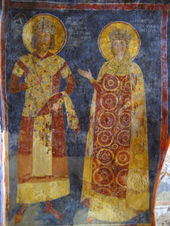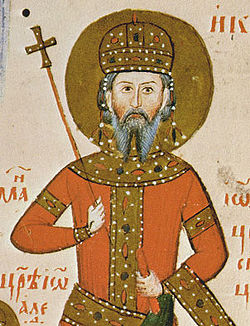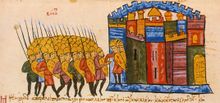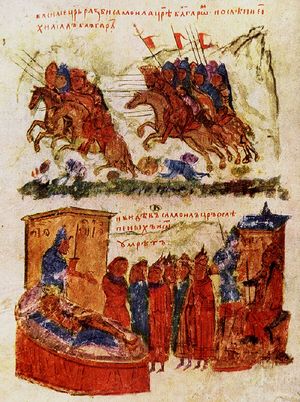First Bulgarian Empire
|
|||||||||||||||||||||||||||||||||||||||||||||||
The First Bulgarian Empire (modern Bulgarian: Първo Българско царство, Parvo balgarsko tsarstvo) was a medieval state founded in the north-eastern Balkans in c. 681 by the Bulgars. At the height of its power it spread between Budapest and the Black Sea and from the Dnieper River in modern Ukraine to the Adriatic Sea.
As the state solidified its position in the Balkans, it entered on a centuries-long interaction, sometimes friendly and sometimes hostile, with the Byzantine Empire. Bulgaria emerged as Byzantium's chief antagonist in the Balkans, resulting in several wars. The two powers however also enjoyed periods of peace and alliance, most notably during the Second Arab siege of Constantinople, where the Bulgarian army played a crucial role in breaking the siege. Byzantium had a strong cultural influence on Bulgaria, which also led to the eventual adoption of Christianity by Bulgaria in 864. After the disintegration of the Avar Khanate, the Bulgarians expanded their territory up to the Pannonian Plain and the Tatra Mountains. Later the Bulgarians confronted the advance of the Pechenegs and Cumans, and achieved a decisive victory over the Magyars, forcing them to establish themselves permanently in Pannonia.
During the late 9th and early 10th centuries, Tsar Simeon I achieved a string of victories over the Byzantines, and expanded the Bulgarian Empire to its apogee. After the annihilation of the Byzantine army in the battle of Anchialus in 917, the Bulgarians laid siege to Constantinople in 923 and 924. The Byzantines eventually recovered, and in 1014 under Basil II, inflicted a crushing defeat on the Bulgarians at the Battle of Kleidion.[1] By 1018, the last Bulgarian strongholds had surrendered to the Byzantine Empire, and the First Bulgarian Empire had ceased to exist.[2] It was succeeded by the Second Bulgarian Empire in 1185.
After the adoption of Christianity in 864 Bulgaria became, for a time, the cultural center of Slavic Europe. Its leading cultural position was further consolidated with the invention of the Cyrillic alphabet in its capital Preslav, and literature produced in the Old Bulgarian language soon began spreading North. Old Bulgarian became the lingua franca of Eastern Europe, where it came to be known as Old Church Slavonic.[3][4] In 927 the fully independent Bulgarian Patriarchate was officially recognized. Later, as a reaction against Byzantine influences in the church, the influential Bogomil sect was born in Bulgaria in the mid-10th century.
Contents |
Nomenclature
The First Bulgarian Empire became known simply as Bulgaria[5] since its recognition by the Byzantine Empire in 681. Between 681 and 864 the country was also known as the Bulgarian Khanate. Some historians use the terms Danube Bulgaria[6], Danube Bulgarian Khanate or Danube Bulgar Khanate[7][8] in order to differentiate it from Volga Bulgaria which emerged from another Bulgar group. During its early existence the country is also called Bulgar state[9] or Bulgar qaghnate[10]. Between 864 and 917/927 the country was known as Principality of Bulgaria or Knyazhestvo Bulgaria.
In Bulgarian historiography it is usually referred to as the First Bulgarian State[11][12] or First Bulgarian Tsardom (Empire). In English language sources the country is often known as the Bulgarian Empire[13]
Created as a union between Bulgars and Slavs, for mutual protection against the Byzantine Empire to the south and the Avars to the north-west. The First Bulgarian Empire was ruled according to the Bulgar tradition with the head of state being the Khan. The Slavs kept significant autonomy and eventually their language and traditions shaped the Bulgarian culture and people with Bulgaria becoming a Slavic country.
Background
During the time of the late Roman Empire, the lands of present-day Bulgaria had been organised in several provinces - Scythia Minor, Moesia (Upper and Lower), Thrace, Macedonia (First and Second), Dacia (north of the Danube), Dardania, Rhodope and Hemimont, and had a mixed population of Romanised Getae and Hellenised Thracians. Several consecutive waves of Slavic migration throughout the 6th and the early 7th century led to the almost complete Slavicisation of the region, at least linguistically.
The Bulgars
 Part of a series on |
|
|---|---|
| Prehistoric Bulgaria | |
|
Karanovo culture · Vinča culture |
|
| Medieval Bulgaria | |
|
Bulgarian Empire Portal |
|
| Ottoman Bulgaria | |
|
Early Ottoman Bulgaria |
|
| Modern Bulgaria | |
|
Principality of Bulgaria · Eastern Rumelia
|
|
|
Bulgaria Portal |
|
The Bulgars (also Bolgars, Bulghars, or Proto-Bulgarians) were a Turkic people,[14][15][16][17][18][19][20][21][22] who migrated into Europe from Central Asia and Mongolia. They reached the Balkan peninsula in the 7th century (according to some sources even earlier). The established theory is that the Bulgars were related to the Huns and originated in Central Asia, but their ethnicity is not entirely clear, as the original Bulgars melded into the local population of what is nowadays Bulgaria.
In 632 Khan Kubrat managed to unite the Bulgar tribes which were under the domination of the Western Turkic Khaganate into a state of their own called by the Byzantine historians Old Great Bulgaria.[23][24] The main records about that country come from the Byzantine Patriarch Nicephorus I and Theophanes the Confessor from the 9th century, the translations of the chronicler John of Nikiû about the political relations between Great Bulgaria and the Byzantine Empire, the description of the Bulgar tribes in the Armenian geographic book Ashkharatsuyts from the 7th century, the correspondence of the Khazar Khagan Josipha shortly after the fall of Great Bulgaria and to a lesser extend from the Nominalia of the Bulgarian khans. According to the analysis of the limited Byzantine and Armenian sources the borders of the country were between the lower course of the Danube to the West, the Black and the Azov Seas to the South, the Kuban River to the East, and the Donets River to the North. The capital of the state was Phanagoria, on the Azov. Kubrat became ally of the Byzantines but the pressure of the Khazars from the east led to the dissolution of Old Great Bulgaria in the second half of the 7th century.
History
Establishment of Bulgaria
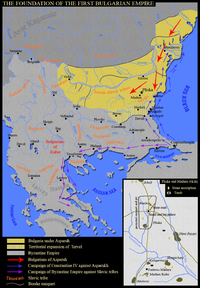
There are two different dates for the year of establishment of present-day Bulgaria, based upon two different interpretations of history. According to the first, after their defeat by the Khazars, another Bulgar tribe, led by Khan Asparuh, moved westward, occupying today's Southern Bessarabia. After a successful war with Byzantium in AD 680, Asparuh's khanate conquered Moesia and Dobrudja [25][26] and was recognised as an independent state under the subsequent treaty signed with the Byzantine Empire in AD 681. The same year is usually regarded as the year of the establishment of present-day Bulgaria.[5]
Another theory is that although Great Bulgaria suffered major territorial losses from the Khazars, it managed to defeat them in the early 670s. Under this interpretation, Khan Asparuh was the direct successor of Khan Kubrat. Therefore, according to some researchers, the year of establishment of present-day Bulgaria has to be considered 632 (the year of the founding of Old Great Bulgaria by Khan Kubrat), rather than 681.
Establishing a firm foothold in the Balkans
After the decisive victory at Ongala in 680 the armies of the Bulgars and Slavs advanced to the South of the Balkan mountains, defeating again the Byzantines who were then forced to sign a humiliating peace treaty which acknowledged the establishment of a new state on the borders of the Empire. They were also to pay an annual tribute to Bulgaria. In the same time the war with the Khazars to the East continued and in 700 Khan Asparough perished in battle with them. The Bulgars lost the territories to the East of the Dnester River, but managed to hold the lands to the West. The Bulgars and the Slavs signed a treaty according to which the head of the state became the Khan of the Bulgars, who had also the obligation to defend the country against the Byzantine, while the Slavic leaders gained considerable autonomy and had to protect the Northern borders along the Carpathian mountains against the Avars.[27]
Khan Asparuh's successor, Khan Tervel helped the deposed Byzantine Emperor Justinian II to regain his throne in 705.[28] In return he was given the area Zagore in Northern Thrace, which was the first expansion of the country to the South of the Balkan mountains. However, three years later Justinian tried to take it back by force, but his army was defeated at Anchialus. In 716 Khan Tervel signed an important agreement with Byzantium. During the siege of Constantinople in 717–718 he sent 50,000 troops to help the besieged city. In the decisive battle the Bulgarians massacred around 30,000 Arabs[29] and Khan Tervel was called The saviour of Europe by his contemporaries.
Internal instability and struggle for survival
In 753 died Khan Sevar who was the last scion of the Dulo clan. With his death the Khanate fell into a long political crisis during which the young country was on the verge of destruction. For just 15 years ruled 7 Khans who were all murdered. There were two main fractions; some nobles wanted uncompromising war against the Byzantines, while others searched for a peaceful settlement of the conflict. That instability was used by the Byzantine Emperor Constantine V (745–775) who launched nine major campaigns aiming at the elimination of Bulgaria. In 763 he defeated the Bulgarian Khan Telets at Anchialus[30][31], but the Byzantines were unable to advance further North. In 775 Khan Telerig, by tricking Constantine to reveal those loyal to him in the Bulgarian Court, executed all the Byzantine spies in the capital Pliska.[32] Under his successor Khan Kardam, the war took a favourable turn after the great victory in the battle of Marcelae[33] in 792. The Byzantines were thoroughly defeated and forced once again to pay tribute to the Khans. As a result of the victory, the crisis was finally overwhelmed and Bulgaria entered the new century stable, stronger and consolidated.
Territorial expansion


Under the great Khan Krum (803–814), also known as Crummus and Keanus Magnus, Bulgaria expanded Northwest and Southwards, occupying the lands between middle Danube and Moldova, the whole territory of present-day Romania, Sofia in 809[34] and Adrianople (modern Odrin) in 813, and threatening Constantinople itself. Between 804 and 806 the Bulgarian armies thoroughly eliminated the Avar Khanate and a border with the Frankish Empire was established along the middle Danube. In 811 a large Byzantine army was decisively defeated in the battle of the Varbitsa Pass.[35] The Byzantine Emperor Nicephorus I was slain along with most of his troops and his skull was used as a drinking cup.[36] Krum immediately took the initiative and moved the war towards Thrace, defeating the Byzantines once more at Versinikia[37] in 813. After a treacherous Byzantine attempt to kill the Khan during negotiations, Krum pillaged the whole of Thrace, seized Odrin and resettled its 10,000 inhabitants in "Bulgaria across the Danube"[38]. He made enhanced preparation to capture Constantinople: 5,000 iron-plated waggons were built to carry the siege equipment[39], the Byzantines even pleaded for help from the Frankish Emperor Louis the Pious.[40] Due to the sudden death of the great Khan, however, the campaign was never launched. Khan Krum implemented law reform, which established equal rules and punishment for all peoples, living within the country's boundaries, intending to reduce the poverty and to strengthen the social ties in his vastly enlarged state.
.png)
Khan Omurtag (814–831) concluded a 30-year peace treaty with the Byzantines[41], thus allowing both countries to restore their economy and finance after the bloody conflicts in the first decade of the century. During his reign, the Northwestern boundaries with the Frankish Empire were firmly settled along the middle Danube by 827. Extensive building was undertaken in the capital Pliska, which included the construction of a magnificent palace, pagan temples, ruler's residence, fortress, citadel, water-main and bath; mainly from stone and brick.
During the short reign of Khan Malamir (831–836), the important city of Plovdiv was incorporated into the country. Under Khan Presian (836–852), the Bulgarians took most of Macedonia and the borders of the country reached the Adriatic and Aegean Seas. The Byzantine historians do not mention any resistance against the Bulgarian expansion in Macedonia, which bring the conclusion that it was largely peaceful.[42] Between 839 and 842 the Bulgarians waged war on the Serbs, but did not make any progress for three years.[43]
Assimilation of Bulgars with Slavs
It is assumed that the Bulgars were greatly outnumbered by the Slav population among which they had settled. Between the 7th and the 10th centuries, the Bulgars were gradually absorbed by the Slavs, adopting a Bulgaro-South Slav language[44] and converting to Christianity (of the Byzantine rite) under Boris I in 864. At that time the process of absorption of the remnants of the old Romanised Thracian population from South of the Danube had already been significant in the formation of this new ethnic group. Modern Bulgarians are normally considered to be of Southern Slavic origin, even though the Slavs were only one of the people that took part in the formation of Bulgarian ethnicity.
Bulgaria under Boris I
The reign of Boris I (852–889) began with numerous setbacks. For ten years the country fought against the Byzantine and Eastern Frankish Empires, Great Moravia, the Croats and the Serbs[45] forming several unsuccessful alliances and changing sides. In August 863 there was a period of 40 days of earthquakes and there was a lean year, which caused famine throughout the country. To cap it all, there was an incursion of locusts.

Christianization
In 864 the Byzantines under Michael III invaded Bulgaria on suspicions that Khan Boris I prepared to accept Christianity in accordance with the Western rites. Upon the news of the invasion, Boris I started negotiations for peace.[46] The Byzantines returned some lands in Macedonia and their single demand was that he accept Christianity from Constantinople rather than Rome. Khan Boris I agreed to that term and was baptised in September 865 assuming the name of his godfather, Byzantine Emperor Michael, and became Boris-Mihail.[47] The pagan title "Khan" was abolished and the title "Knyaz" assumed in its place. The reason for the conversion to Christianity, however, was not the Byzantine invasion. The Bulgarian ruler was indeed a man of vision and he foresaw that the introduction of a single religion would complete the consolidation of the emerging Bulgarian nation, which was still divided on a religious basis. He also knew that his state was not fully respected by Christian Europe and its treaties could have been ignored by other signatories on religious basis.
Тhe Byzantines' goal was to achieve with peace what they were unable to after two centuries of warfare: to slowly absorb Bulgaria through the Christian religion and turn it into a satellite state, as naturally, the highest posts in the newly founded Bulgarian Church were to be held by Byzantines who preached in the Greek language. Knyaz Boris I was well aware of that fact and after Constantinople refused to grant autonomy of the Bulgarian Church in 866, he sent a delegation to Rome declaring his desire to accept Christianity in accordance with the Western rites along with 115 questions to Pope Nicolas I[48][49]. The Bulgarian ruler desired to take advantage of the rivalry between the Churches of Rome and Constantinople as his main goal was the establishment of an independent Bulgarian Church in order to prevent both the Byzantines and the Catholics from exerting influence in his lands through religion. The Pope's detailed answers to Boris' questions were delivered by two bishops heading a mission whose purpose was to facilitate the conversion of the Bulgarian people. However, Nicolas I and his successor Pope Adrian II also refused to recognize an autonomous Bulgarian Church, which cooled the relations between the two sides, but Bulgaria's shift towards Rome made the Byzantines much more conciliatory. In 870, at the Fourth Council of Constantinople, the Bulgarian Church was recognized as an Autonomous Eastern Orthodox Church under the supreme direction of the Patriarch of Constantinople. It was the first Church officially accepted, apart from the Churches of Rome and Constantinople. Eventually, in 893, the Old Bulgarian language became the third official language, recognized by the Churches and used during services and in Christian literature.
Creation of the Slavic Writing System
Although the Bulgarian Knyaz succeeded in securing an autonomous Church, its higher clergy and theological books were still Greek, which impeded the efforts to convert the populace to the new religion. Between 860 and 863 the Byzantine monks of Greek origin[50] Saint Cyril and Saint Methodius created the Glagolitic alphabet, the first Slavic alphabet by order of the Byzantine Emperor, who aimed to convert Great Moravia to Orthodox Christianity. However, these attempts failed and in 886 their disciples Clement of Ohrid, Naum of Preslav and Angelarius, who were banished from Great Moravia, reached Bulgaria and were warmly welcomed by Boris I. The Bulgarian Knyaz commissioned the creation of two theological academies to be headed by the disciples where the future Bulgarian clergy was to be instructed in the local vernacular. Clement was sent to Ohrid[51] in Southwestern Bulgaria, where he taught 3,500 pupils between 886 and 893. Naum established the literary school in the capital Pliska, moved later to the new capital Preslav. In 893, Bulgaria adopted the Glagolitic alphabet and Old Church Slavonic (Old Bulgarian) language as official language of the church and state, and expelled the Byzantine clergy. In the early 10th century the Cyrillic alphabet was created at the Preslav Literary School.
The Golden Age

By the late 9th and the beginning of the 10th century, Bulgaria extended to Epirus and Thessaly in the South, Bosnia in the West and controlled the whole of present-day Romania and Eastern Hungary to the North. With Byzantine support, a Serbian state came into existence in the mid-ninth century as a response to the Bulgarian expansion West of the Morava[52]. Switching loyalties between Bulgaria and the Byzantines, the Serb rulers successfully resisted several Bulgarian invasions until 924 A.D., when it was fully subordinated under the general and possibly Count of Sofia Marmais. Under Tsar Simeon I (Simeon the Great), who was educated in Constantinople, Bulgaria became again a serious threat to the Byzantine Empire and reached its greatest territorial extension[53]. Simeon I hoped to take Constantinople and fought a series of wars with the Byzantines throughout his long reign (893–927). The border close to the end of his rule reached the Northern limits of Attica in the South. Simeon I styled himself "Emperor (Tsar) of the Bulgarians and Autocrat of the Greeks", a title which was recognized by the Pope, but not of course by the Byzantine Emperor nor the Ecumenical Patriarch of the Eastern Orthodox Church. He was recognized "Emperor (Tsar) of the Bulgarians" by the Byzantine Emperor and the Patriarch only at the end of his rule.
Between 894 and 896 he defeated the Byzantines and their allies the Magyars[54] in the so called "Trade War" because the pretext of the war was the shifting of the Bulgarian market from Constantinople to Solun[55][56]. In the decisive battle of Bulgarophygon the Byzantine army was routed[57] and the war ended with favourable for Bulgaria peace which was, however, often violated by Simeon I[58]. In 904 he captured Solun which was previously looted by the Arabs and returned it to the Byzantines only after Bulgaria received all Slavic-populated areas in Macedonia and 20 fortress in Albania, including the important town Drach[59].
After the unrest in the Byzantine Empire that followed the death of Emperor Alexander in 913, Simeon I invaded Byzantine Thrace, but was persuaded to stop in return for official recognition of his Imperial title and marriage of his daughter to the infant Emperor Constantine VII[60][61]. Simeon I was supposed to become regent of the Emperor and temporary to rule the Byzantine Empire. However, after a plot in the Byzantine court, the mother of Emperor Constantine VII, Empress Zoe, rejected the marriage and Simeon's title, and both sides prepared for a decisive battle. By 917 Simeon I broke every attempts of his enemy to form an alliance with the Magyars, the Pechenegs and the Serbs, and Byzantines were forced to fight alone. On 20 August the two armies clashed at Anchialus in one of the greatest battles in the Middle Ages[62]. The Byzantines suffered an unprecedented defeat leaving 70,000 killed on the battlefield. The pursuing Bulgarian forces defeated the reminder of the enemy armies at Katasyrtai[63]. However, Constantinople was saved by a Serb attack from the West; the Serbs were thoroughly defeated, but that gave precious time for the Byzantine admiral and later Emperor Romanos Lakepanos to prepare the defense of the city. In the following decade the Bulgarians gained control of the whole Balkan peninsula with the exception of Constantinople and Pelopones.
Decline
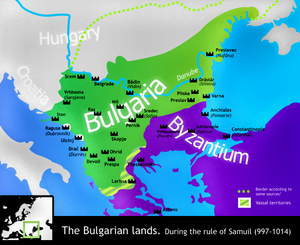
After Simeon's death, however, Bulgarian power slowly declined. In a peace treaty in 927 the Byzantines officially recognized the Imperial title of his son Peter I and the Bulgarian Patriarchate. Peace with Byzantium, however, did not bring prosperity to Bulgaria. In the beginning of his rule the new Emperor had internal problems and unrest with his brothers, and in the 930s was forced to recognize the independence of Rascia[64]. The biggest blow came from the North: between 934 and 965 the country suffered five Magyar invasions[65]. In 944 Bulgaria was attacked by the Pechenegs, who looted the Northeastern regions of the Empire. Under Peter I and Boris II the country was divided by the egalitarian religious heresy of the Bogomils[66].
In 968 the country was attacked by the Kievan Rus, whose leader, Svyatoslav I, took Preslav[67] and established his capital at Preslavets[68]. Three years later, Byzantine Emperor John I Tzimiskes interfered in the struggle and defeated Svyatoslav at Dorostolon. Boris II was captured and ritually divested of his imperial title in Constantinople,[69] and eastern Bulgaria was proclaimed a Byzantine protectorate.
Fall
After the Byzantine betrayal the lands to the West of the Iskar River remained in Bulgarian hands and resistance against the Byzantines was headed by the Comitopuli brothers. By 976, the fourth brother, Samuil concentrated all power in his hands after the deaths of his eldest brother. When the rightful heir to the throne, Roman, escaped from captivity in Constantinople, he was recognized as Emperor by Samuil in Vidin[70] and the later remained the chief commander of the Bulgarian army. A brilliant general and good politician, he managed to turn the fortunes to the Bulgarians. The new Byzantine Emperor Basil II was decisively defeated in the battle of the Gates of Trajan in 986 and barely escaped[71][72]. Five years later he eliminated the Serbian state of Rascia[73]. In 997, following the death of Roman, who was the last heir of the Krum dynasty, Samuil was proclaimed Emperor of Bulgaria[74]. However, after 1001 the war turned in favor of the Byzantines who captured the old capitals Pliska and Preslav in the same year, and beginning ub 1004 launched annual campaigns against Bulgaria. The Byzantine further benefited from a war between Bulgaria and the newly established Kingdom of Hungary 1003. The Byzantine victories of Spercheios and Skopje decisively weakened the Bulgarian army, and in annual campaigns, Basil methodically reduced the Bulgarian strongholds. Eventually, at the Battle of Kleidion in 1014, the Bulgarians were completely defeated.[1] The Bulgarian army was captured, and it is said that 99 out of every 100 men were blinded, with the remaining hundredth man left with one eye so as to lead his compatriots home. When Tsar Samuil saw the broken remains of his army, he suffered a heart attack and died. By 1018, the last Bulgarian strongholds had surrendered, and the First Bulgarian Empire was abolished.
Culture

The cultural heritage of the First Bulgarian Empire is usually defined in Bulgarian historiography as the Pliska-Preslav culture named after the first two capitals Pliska and Preslav where most of the surviving monuments are concentrated. Many monuments of that period have been found around Madara, Shumen, Novi Pazar, the village of Han Krum in north-eastern Bulgaria, as well in the territory of modern Romania where the Romanian archaeologists called it the Dridu culture[75] Remains left by the First Empire have been discovered in southern Bessarabia, now divided between the Ukraine and Moldova.[76]
Architecture
The most important feature of the early Bulgarian architecture was the monumental construction known to the Romans but which was not used in the contemporary Byzantine Empire. There were two main types of construction employed in the building of Pliska. For the first one the construction matherials were timber and bricks. The second type was construction of defensive walls using large carved limestone blocks put together with plaster. The same method was used in the construction of the fortress of Preslav, the military camp at Han Krum, the hunting palace in Madara or in the fortress on the island of Păcuiul lui Soare.[77] Fortresses were mainly situated in the plains unlike those constructed during the Second Bulgarian Empire.
After the adoption of Christianity in 864 there was intensive construction of churches and monasteries throughout the Empire including the Great Basilica of Pliska which was one of the biggest structures of the time with its length of 99 m and the splendid Golden Church in Preslav. The churches built during that period were mostly with three naves. The Bulgarian capital was also famous for its ceramics which adorned the public and religious buildings. Beautiful icons and church altars were made of special ceramic tiles. There were numerous goldsmith and silversmith workshops who produced fine jewellery.
Ceramics

One of the most famous features of the Pliska-Preslav culture was the decoration of palaces and churches with lacquered ceramic plates, which may indicate a Near Eastern (Arabic) influence. The ceramic plates were painted mostly with geometric or vegetative elements, while a few feature depictions of saints. Among the most notable of the latter is the well-preserved 20-tile Icon of St Theodore, found in the ruins of the Saint Panteleimon Monastery in the outskirts of Preslav.[78] The tiles were either flat or tubular, and were arranged to form friezes of repeating motifs. Due to the destruction of Pliska and Preslav only fragments and details of the ceramic decoration have survived. Most finds of tiles, as well as archaeological evidence of the workshops producing them, come from Preslav and the surrounding region (chiefly the village of Patleina).[79]
The main sources for Bulgarian domestic use-oriented pottery are the necropoleis at Novi Pazar, Devnya and Varna. The vessels were made with a potter's wheel, unlike Slavic practice. Two-storey ovens were used for the annealing of the pottery. The shape and decoration of the early Bulgarian pottery was similar to that found in northern Caucasus, the Crimea and the shores of the Sea of Azov.
Literature
The Bulgarian literature is the oldest Slavic literature. Missionaries from Thessalonica, Cyril and Methodius, devised the Glagolitic alphabet, which was adopted in the Bulgarian Empire around 886. The alphabet and the Old Bulgarian language gave rise to a rich literary and cultural activity centered around the Preslav and Ohrid Schools, established by order of Boris I in 886. In the beginning of 10th century AD, a new alphabet—the Cyrillic alphabet - was developed on the basis of Greek and Glagolitic cursive at the Preslav Literary School. According to an alternative theory, the alphabet was devised at the Ohrid Literary School by Saint Clement of Ohrid, a Bulgarian scholar and disciple of Cyril and Methodius. A pious monk and hermit St. Ivan of Rila (Ivan Rilski, 876–946), became the patron saint of Bulgaria.
During his reign Simeon gathered many scholars in his court who translated enormous number of books from Greek and wrote many new works. Among the most prominent figures were Constantine of Preslav, John Exarch and Chernorizets Hrabar who is believed by some historians to have been Simeon himself. Chernorizets Hrabar wrote his popular work An Account of Letters, Clement of Ohrid worked on translations from Greek and is credited with several important religious books, John Exarch wrote his Shestodnev and translated On Orthodox Christianity by John of Damascus, Naum of Preslav also had a significant contribution. Bulgarian scholars and works influenced most of the Slavic world, spreading Old Church Slavonic, the Cyrillic and the Glagolithic alphabet to Kievan Rus', medieval Serbia and medieval Croatia.
Religion
After the creation of the Bulgarian state the Bulgars and the Slavs continued to practice their indigenous religions. The Bulgar religion was monotheistic and they believed in Tangra, the God of the Sky. When Omurtag and Leo V the Armenian concluded a peace treaty in 815, the Byzantine Emperor had to make an oath according to the Bulgarian traditions. The Byzantine historians recorded that the "most Christian" ruler had to perform different pagan rites including cutting dogs and use them as witnesses for his oath.[80] The Slavs worshipped numerous deities. Their supreme god was Perun. There are evidences that Christianity remained widespread in Bulgaria during the first 150 years of existence of the state.
In the mid 9th century Boris I decided to adopt Christianity in order to unite firmly the population of the country.
See also
|
|
Notes
- a. [a] Bulgaria is usually accepted to have been established in 681 when the Byzatnine Empire acknowledged the country as a souveregin state in a treaty. However, some historians argue that Bulgaria existed since 632 with the creation of Old Great Bulgaria by Khan Kubrat.
Footnotes
- ↑ 1.0 1.1 Angold 1997
- ↑ Norwich 1998
- ↑ Schenker, Alexander (1995). The Dawn of Slavic. Yale University Press. pp. 185–186, 189–190.
- ↑ Benjamin W. Fortson. Indo-European Language and Culture: An Introduction, p. 374
- ↑ 5.0 5.1 Runciman, S. A History of the First Bulgarian Empire, p. 27
- ↑ Vladimirov, G. Danube Bulgaria and Volga Bulgaria, Orbel, 2005
- ↑ Dennis Sinor, The Cambridge history of early Inner Asia, Volume 1, Cambridge University Press, 1990, ISBN 0521243041, 9780521243049, p.62
- ↑ Christopher I. Beckwith, Empires of the Silk Road: a history of Central Eurasia from the Bronze Age, Princeton University Press, 2009, ISBN 0691135894, 9780691135892, p.117
- ↑ Whittow, M. The making of Byzantium, 600-1025, University of California press, Los Angeles, p. 272
- ↑ Whittow, M. The making of Byzantium, 600-1025, University of California press, Los Angeles, p. 279
- ↑ John V. A. Fine, "The Late Medieval Balkans: A Critical Survey from the Late Twelfth Century", 1994, p.55
- ↑ R. J. Crampton, "A concise history of Bulgaria", 2005, p.21
- ↑ Stephenson, P. Byzantium's Balkan frontier, p. 18
- ↑ Encyclopaedia Britannica Online, Bulgars
- ↑ http://books.google.com.tr/books?id=4iwHp8amsdEC&pg=PA32&dq=bulgars+turkic&lr=&cd=13#v=onepage&q=bulgars%20turkic&f=false
- ↑ http://books.google.com.tr/books?id=dQt6XWloU10C&pg=PT239&dq=bulgars+turkic&lr=&cd=17#v=onepage&q=&f=false
- ↑ http://books.google.com.tr/books?id=ifW3AAAAIAAJ&q=bulgars+turkic&dq=bulgars+turkic&lr=&cd=20
- ↑ http://books.google.com.tr/books?id=3ElpAAAAMAAJ&q=bulgars+turkic&dq=bulgars+turkic&lr=&cd=21
- ↑ http://books.google.com.tr/books?id=22NNIjrpd20C&pg=PA271&dq=bulgars+turkic&lr=&cd=22#v=onepage&q=bulgars%20turkic&f=false
- ↑ http://books.google.com.tr/books?id=u-SsbHs5zTAC&pg=RA1-PA504&dq=bulgars+turkic&lr=&cd=32#v=onepage&q=bulgars%20turkic&f=false
- ↑ http://books.google.com.tr/books?id=ANdbpi1WAIQC&pg=PA404&dq=bulgars+turkic&lr=&cd=33#v=onepage&q=bulgars%20turkic&f=false
- ↑ http://books.google.com.tr/books?id=c788wWR_bLwC&pg=PA354&dq=bulgars+turkic&lr=&cd=39#v=onepage&q=bulgars%20turkic&f=false
- ↑ Theophanes the Confessor, Chronographia
- ↑ Patriarch Nicephorus, Opuscula historica
- ↑ Theophanes, ibid., р. 358
- ↑ Theophanes, ibid., p. 359
- ↑ Theophanes, ibid., p. 359
- ↑ Pauli Historia Langobardorum VI.31, MGH SS rer Lang I, p. 175
- ↑ Theophanes, ibid., p. 397
- ↑ Nicephorus, ibid., p. 69
- ↑ Theophanes, ibid., p. 433
- ↑ Theophanes, ibid., р. 447–448
- ↑ Theophanes, ibid., p. 467
- ↑ Classen, J. (ed.) (1841) Theophanes Chronographia, Corpus Scriptorum Historiæ Byzantinæ (Bonn) ("Theophanes") Vol, I, 6301/802, pp. 752-3
- ↑ Theophanes, ibid., р. 492
- ↑ Martindale, J. R. Prosopography of the Byzantine Empire I: (641-867), 2001
- ↑ Scriptor incertus, ibid., p. 337–339
- ↑ Scriptor incer., ibid., p. 346–347
- ↑ Scriptor incert., ibid., p. 347–348
- ↑ Annales Laurissenses minores, s. an. 814
- ↑ Theophanes Continuatus II, 17-18, pp. 64-6
- ↑ Bekker, Constantini Porphyrogeniti De Thematibus et De Administrando Imperio, Corpus Scriptorum Historiæ Byzantinæ, 1st ed., Bonn, 1840, pp. 154-155
- ↑ Bekker, Constantini Porphyrogeniti De Thematibus et De Administrando Imperio, Corpus Scriptorum Historiæ Byzantinæ, 1st ed., Bonn, 1840, p. 154
- ↑ L. Ivanov. Essential History of Bulgaria in Seven Pages. Sofia, 2007.
- ↑ Konstantinos Porphyrogenitos De Administrando Imperio 32, p. 154
- ↑ Georgius Monachus Continuatus, p. 824
- ↑ Georgius Monachus Continuatus, loa cit., Logomete
- ↑ Johannes VIII Papa. Epistolae, p. 159
- ↑ Anastasius Bibliothecarius, pp. 1373—4
- ↑ Barford, P. M. (2001). The Early Slavs. Ithaca, New York: Cornell University Press
- ↑ Vita S. démentis
- ↑ The Early Medieval Balkans. A Critical Survey from the 6th to the Late 12th Century. J V A Fine, Jr. Pg 110 they (the Bulgarians) became a threat to the Serbs..; presumably this danger proved to be a catalyst in uniting of various Serbian tribes to oppose it. The Byzantines were....interested in building a stronger Serbia
- ↑ Енциклопедия България, Академично издателство "Марин Дринов", 1988
- ↑ Fine (1991), p. 139
- ↑ 55.0 55.1 Delev, Bǎlgarskata dǎržava pri car Simeon.
- ↑ Fine (1991), p. 137
- ↑ Златарски, История на Първото българско царство, с. 316.
- ↑ Златарски, История на Първото българско царство, с. 321.
- ↑ Бакалов, История на България, "Симеон І Велики"
- ↑ Runciman, A history of the First Bulgarian Empire, p. 157
- ↑ Fine, The Early Medieval Balkans, pp. 144–148
- ↑ Dimitrov, Bulgaria: illustrated history.
- ↑ De Boor, Сarl Gothard (1888). Vita Euthymii. Berlin: Reimer, p. 214
- ↑ Constantine Porphyrogennetus. Op. cit., pp. 158—9
- ↑ Theophanes Continuatus, pp. 462—3,480
- ↑ Nicolaus Papa. Response, p. 1015
- ↑ Cedrenus: II, p. 383
- ↑ Chronique dite de Nestor, pp. 53—4
- ↑ Leo Diaconus, pp. 158-9
- ↑ Prokić, p. 28
- ↑ Skylitzes, pp. 436–438
- ↑ Гильфердинг, А (1868). Письма об истории сербов и болгар (in Russian), p. 209.
- ↑ Шишић, p. 331
- ↑ Розен, p. 43
- ↑ „История на българите: изкривявания и фалшификации“, Димитър Овчаров, сборник, ч. 1, София, „ТанНакРа“, стр. 170-200
- ↑ Чеботаренко, Г. Ф. Материалы к археологической карте памятников VIII-Х вв. южной части Пруто-Днестровского междуречья//Далекое прошлое Молдавии, Кишинев, 1969, с. 224-230
- ↑ Р. Diaconu, D. Vilceanu, Pácuiul lui Soare. Cetatea bizantina, I, Bucureşti, 1972
- ↑ Kazhdan 1991, p. 335
- ↑ Kazhdan 1991, pp. 335, 2084–2085
- ↑ Andreev, J. The Bulgarian Khans and Tsars (Balgarskite hanove i tsare, Българските ханове и царе), Veliko Tarnovo, 1996, pp. 57-58, ISBN 954-427-216-X
References
- Andreev, Jordan; Milcho Lalkov (1996) (in Bulgarian). The Bulgarian Khans and Tsars. Abagar. ISBN 954-427-216-X.
- Zlatarski, Vasil N. (1918) (in Bulgarian). Medieval History of the Bulgarian State, Vol I: History of the First Bulgarian Empire, Part I: Age of Hunn-Bulgar Domination (679–852). Sofia: Science and Arts Publishers, 2nd Edition (Petar Petrov, Ed.), Zahari Stoyanov Publishers, 4th Edition, 2006. ISBN 9547366284. http://navigator.idg.bg/index.php?type=2&p=2169&id=4514676. (История на българската държава през средните векове. Том I., История на Първото българско царство. Част I. Епоха на хуно-българското надмощие (679–852), София 1918)
- Zlatarski, Vasil N. (1927) (in Bulgarian). Medieval History of the Bulgarian State, Vol I: History of the First Bulgarian Empire, Part II: From Slavianization to the Fall of the First Bulgarian Empire (852–1018). Sofia: Bulgarian Academy of Sciences, 2002. http://knigabg.com/index.php?page=book&id=2271&PHPSESSID=6e7a644cf7f0100a222bb7d55953be18. (История на българската държава през средните векове. Том I. История на Първото българско царство. Част II. От славянизацията на държавата до падането на Първото царство (852–1018)], София 1927)
- Бакалов, Георги; Милен Куманов (2003) (in Bulgarian). Електронна издание – История на България. София: Труд, Сирма. ISBN 9844830679.
- Цанев, Стефан (2006) (in Bulgarian). Български хроники. София, Пловдив: Труд, Жанет 45. ISBN 954-528-610-5.
- Делев, Петър; Валери Кацунов, Пламен Митев, Евгения Калинова, Искра Баева, Боян Добрев (2006) (in Bulgarian). История и цивилизация за 11. клас. Труд, Сирма.
- (in Bulgarian) Българите и България. Министерство на външните работи на България, Труд, Сирма. 2005. http://www.mfa.government.bg/history_of_Bulgaria/.
- Fine, Jr., John V.A. (1991). The Early Medieval Balkans. Ann Arbor: University of Michigan Press. ISBN 978-0472081493.
- Kazhdan, Alexander, ed. (1991), Oxford Dictionary of Byzantium, Oxford University Press, ISBN 978-0-19-504652-6
- Runciman, Steven (1930). A History of the First Bulgarian Empire. G. Bell & Sons, London. http://www.questia.com/library/book/a-history-of-the-first-bulgarian-empire-by-steven-runciman.jsp.
- Cawley, Charles Medieval Lands, Foundation for Medieval Genealogy, 2006–2007
| State | Military | Culture | |
|---|---|---|---|
|
Origin
States
De facto independent states from the Second Empire
Administration
Important rulers
First Bulgarian Empire Asparukh • Tervel • Krum • Omurtag • Boris I • Simeon I the Great • Peter I • Samuil Second Bulgarian Empire Ivan Asen I • Kaloyan • Ivan Asen II • Constantine Tikh Asen • Michael Shishman • Ivan Alexander |
Conflicts
Major battles
First Bulgarian Empire Battle of Ongal • Siege of Constantinople • Battle of Marcellae • Battle of Pliska • Battle of Southern Buh • Battle of Acheloos • Battle of the Gates of Trajan • Battle of Kleidion Second Bulgarian Empire Battle of Tryavna • Battle of Adrianople • Battle of Klokotnitsa • Battle of Skafida • Battle of Velbazhd • Battle of Rusokastro • Battle of Chernomen • Siege of Tarnovo Major uprisings
|
Literature
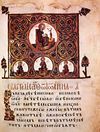
Prominent writers and scholars: Naum of Preslav • Clement of Ohrid • Chernorizets Hrabar • Constantine of Preslav • John Exarch • Evtimiy of Tarnovo • Gregory Tsamblak Art and Architecture
Famous examples: Madara Rider • Great Basilica of Pliska • Round Church in Preslav • Holy Forty Martyrs Church in Tarnovo • Boyana Church • Tsarevets • Baba Vida Religion

Economy
|
|
|
||||||||||||||||||||||||||
|
|||||||||||||||||
|
||||||||||||||||||||||||||||||||||||||||||




